 Concave Mirrors
Concave Mirrors
Resource:
The Science Reasoning Center: Concave Mirrors
Grade Level: High School
Description:
This passage describes a collection of experiments in which students investigate the characteristics of images formed by a concave mirror. Information is presented in the form of two diagrams and a data table. Questions target a student's ability to analyze and interpret a complex diagram, to identify the effect of variations in one quantity upon another quantity, to draw conclusions that are supported by one or more data presentations, to identify evidence that supports a conclusion, to transform data in a table into a graph, and to interpolate and extrapolate from data in a table.
This activity aligns with the three dimensions of the Next Generation Science Standards in the manner described below:
| Patterns: Empirical evidence is needed to identify patterns. |
“It is man’s duty to discover the order and regularity of the world,” said Isaac Newton, to whom we attribute much of our understanding of light and optics. Through experimentation, Newton was able to describe many patterns in how light reflects off mirrors. In this passage, students are challenged to see such patterns as well by considering collected data from three experiments. The inverse relationship between object distance and image distance or between object distance and image size are two of many patterns that will be explored in this passage and the questions that follow. |
| Cause and Effect: Systems can be designed to cause a desired effect. |
As scientists and engineers know quite well, by understanding how changing one variable affects another, one can design systems to have a desired effect. This passage explores relationships between an object’s location in front of a concave mirror and how this location affects the location and size of the image formed. And while there are many devices that use concave mirrors in everyday life, as students understand such relationships they can appreciate how these devices work and how they can be modified to have the desired effect. |
| Planning and Carrying Out Investigations: Plan an investigation or test a design individually and collaboratively to produce data to serve as the basis for evidence in building/revising models, supporting explanations for phenomena, or testing solutions to problems. Consider possible confounding variables and ensure variables are controlled. |
This passage illustrates a well-designed set of experiments where one variable is change in each experiment and the responding (dependent) variables are recorded. And while this passage does not ask students to plan the investigation itself, they are asked to identify which experiments give evidence for a particular claim. For example, one question states that when an object is far from a concave mirror the image of the object will be reduced in size; the question then requires the reader to consider which experiment could be used to illustrate this claim. |
| Analyzing and Interpreting Data: Analyze data using tools, technologies, and/or models (e.g., computational, mathematical) in order to make valid and reliable scientific claims or determine an optimal design solution. |
The vast majority of questions presented to students at the end of this passage ask them to analyze and interpret data that has been presented through two figures and one data table. Questions target a student's ability to make meaning of a complex diagram, to identify the effect of variations in one quantity upon another quantity, to draw conclusions that are supported by one or more data presentations, to identify evidence that supports a conclusion, to transform data in a table into a graph, and to interpolate and extrapolate from data in a table. |
Associated Reading from The Physics Classroom
Other Supporting Pages at The Physics Classroom:
View Infographic.
(Coming Soon)
Search the NGSS Corner
Maybe you're looking for something really specific that pertains to a desired topic and emphasizes one or more of the listed NGSS dimensions. Why not try a search of this section of our website? Simply select from one or more of the pull-down menus and click Search This page will reload and a collection of possibilities will be displayed in this section of the page and sorted by relevancy.